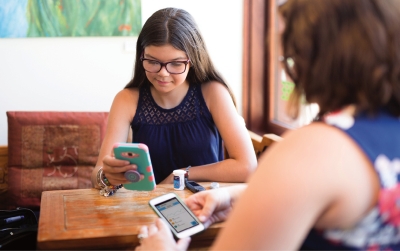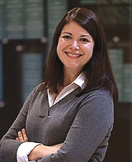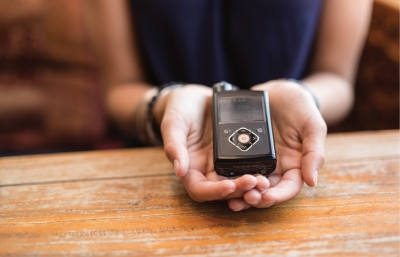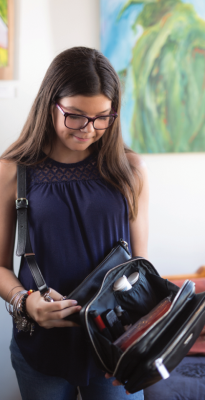Diabetes Management and Technology: Mobile App Links T1D Tweens and Teens with their Parents
- Bree Holtz
- Assistant Professor
- Department of Advertising and Public Relations
- College of Communication Arts and Sciences

Cell phones play a vital role in helping Alexia (Lexi) Zaffarano and her mother, Jennifer, manage the early teenager's Type 1 diabetes.
As any parent in recent history can tell you, many kids start asking for cell phones long before adults think it's necessary. But what if your child has a serious medical condition?
 Bree Holtz of MSU's Department of Advertising and Public Relations conducts research that utilizes communication technologies to enhance and improve health care access and delivery. She leads a study to develop and test a mobile phone app for 10- to 15-year-olds with Type 1 diabetes that links them with a complementary app developed for their parents. The goal is to help those young people transition to self-management and positive self-care, and simultaneously provide parents with the oversight and input necessary to ease their concerns.
Bree Holtz of MSU's Department of Advertising and Public Relations conducts research that utilizes communication technologies to enhance and improve health care access and delivery. She leads a study to develop and test a mobile phone app for 10- to 15-year-olds with Type 1 diabetes that links them with a complementary app developed for their parents. The goal is to help those young people transition to self-management and positive self-care, and simultaneously provide parents with the oversight and input necessary to ease their concerns.
The American Diabetes Association awarded a three-year, $593,042 grant to develop the app. In addition to Holtz and the MSU team, partners include Sparrow Health System, University of Michigan Medical School, and University of Alabama-Birmingham.
Questions that the researchers hope to answer include: If you provide an adolescent with an app on a cell phone, can that app help to better manage the diabetes? Is there a possibility that using the app can be fun? Can it promote better communication between the child and parent, especially when they are apart? Does it provide information that eases parental concerns?
What Is T1D?
According to the JDRF (formerly the Juvenile Diabetes Research Foundation), Type 1 diabetes can emerge in children and adults at any age. Unlike Type 2, it has nothing to do with diet or lifestyle.
When a healthy person eats, the pancreas releases insulin and the body makes energy out of the sugars in carbohydrates (also known as glucose). It is a life-functioning part of a body's metabolism.
Type 1 diabetes is an autoimmune disease. It occurs when a person's immune system attacks beta cells, destroys them, and causes the pancreas to stop producing insulin. Without that process working correctly, excess blood sugar in a human body can lead to nerve damage, eye damage, amputation, kidney failure, stroke, and other serious medical problems. Dangerously low blood sugar can cause seizures, loss of consciousness, or coma.
Insulin is a hormone that works as a transportation escort in the bloodstream to help glucose get into the cells. Cells that don't get enough insulin are starving while the blood sugar levels are fluctuating between high and low depending on what food—and type of food—is eaten or not eaten.
A healthy lifestyle for anyone with diabetes requires daily vigilance. T1D patients must learn to measure food, count carbohydrates, and eat their food. They also need to factor in exercise, eating times, and daily activities. To balance it all, they need to monitor their blood sugar levels multiple times each day by pricking their finger and testing blood drops in a glucose monitor.
Adults might consider these irritating but necessary facts. Adolescents, however, can feel burdened and overwhelmed with finger pokes to check blood sugar levels, insulin injections, or pump infusions. In addition, they often want to avoid drawing attention to themselves or having their friends witness their health maintenance. Parents are protective and hesitant to release responsibilities to their adolescent because of the seriousness of lapsed or miscalculated management.
According to the JDRF, children diagnosed at an early age must have parent involvement to manage their diabetes. As time progresses, those kids typically want, and need, evolving independence. That requires crucial self-care responsibilities for the young person, and added stressors for their parents and other adults in their life.
That's where the cell phone enters the picture. Holtz and the team are designing a mobile app that will encourage kids to enjoy positive rewards for sticking to their T1D plan, provide oversight for parents so they can see their child's glucose numbers, and provide communication prompts and messages that keep dialogue going between the two.
MyT1DHero
The app is called MyT1DHero. Kids using it receive an avatar and earn points to redeem items for their avatar, such as costume pieces and accessories. The rewards are earned by checking their glucose numbers and recording the information.
Parents have a complementary app on their mobile phone that lets them view their child's information. This provides feedback about whether the adolescent is in tune with what needs to be done, and whether they should be concerned.
"The first goal is to develop an app that the kids want to use," said Holtz. "The next goal is to develop the app so that parents can see whether or not their son or daughter is doing the necessary self-management. The third goal is to create a communication process between them that reduces conflict."
Project manager Katharine (Katie) Murray works with Holtz to juggle details with T1D kids and parents, web developers, and researchers. Project partners include Julie Dunneback with Sparrow Health System and Michael Wood with the University of Michigan Health System, along with MSU colleagues Denise Hershey, Shelia R. Cotten, and Amanda Holmstrom.
The grant is in the second year of a 2016-2018 timeline. During the first year, the prototype was developed from focus groups involving T1D kids and their parents who were recruited to supply feedback on the proposed mobile app. The team has just finished testing the prototype and is now getting ready for their intervention trial/study.
"One thing we have learned about is 'sugar number nagging,' where a parent constantly asks the child, 'Have you tested? What's your number? Have you done what you need to do to correct that number?' We have implemented message prompts that remove the parent from that responsibility so the child can dialogue with the app to answer those questions. We are testing an effective way to improve communication and relieve some of the strain on both of them," said Holtz.
What It's Like to Have T1D When You Are 12 Years Old

Lexi holds her insulin pump, which helps her keep her blood glucose levels within her target ranges. Insulin pumps deliver rapid- or short-acting insulin 24 hours a day through a catheter placed under the skin.
Alexia (Lexi) Zaffarano was a sixth grade student in the Metro Detroit area when she was diagnosed with T1D in June 2016, approximately two weeks before her 12th birthday. She has been pressed into responsibilities for her health that are far beyond her age level. Lexi and her mother Jennifer participated in testing the MyT1DHero prototype.
"I can hold my pancreas in my hand," said Lexi, pulling out her insulin pump from a clip on her waistband.
She fluently describes the contents of her constant companion, an unassuming black bag that looks like a middle-aged woman's purse rather than a middle schooler's lifeline. It contains blood sugar testing supplies, extra batteries for her continuous glucose monitoring system (CGM) and Medtronic insulin pump (i.e., the "pancreas in her hand"). There are Skittles, fast-acting insulin, ketone test strips, extra syringes, and other items essential for daily use or emergencies.
It is coming up on a one-year anniversary for Lexi's diagnosis. She experienced the fatigue, irritability, excessive thirst, and other symptoms that accompany Type 1 diabetes. "My friends told me that I wasn't myself," said Lexi.

Lexi carries her bag filled with T1D supplies everywhere she goes.
Diagnosis led to a considerable amount of education for Jennifer, Lexi, and their family members. Lexi has learned to calculate carbs, test her blood sugar levels throughout the day, and maintain or self-correct her numbers with food and insulin. She just completed seventh grade, is approaching a birthday where she will become a teenager, and is absorbed in all kinds of activities.
Sample Pre-programmed Messages in the MyT1DHero App
From kids to parents:
- Can you order me supplies?
- Will you check my blood glucose with me?
- I need help managing this today.
- I'm feeling down today.
- Can I have a hug?
- Can we spend time together today?
From parents to kids:
- Is there anything I can do to help?
- How are you feeling about diabetes today?
- What was something that made you laugh today?
- What would you rate your day on a scale of 1 to 10? Why?
Parent responses to getting the child's blood glucose number:
- Thanks for the number!
- You're doing a great job at tracking your numbers!
- Your number looks a little above/below range, how are you feeling?
- I know you would rather be doing something else, so thank you for entering your number, it means a lot to me!
"When I am at cheerleading I want to be like my friends. They don't think about what they have to eat before or after they cheer, but I do. We were at a competition one day and everyone was eating these huge muffins. I kind of planned—and worked really hard—to do everything else I had to do so I could have one, too," said Lexi.
One of the tougher challenges about diabetes is living with the unpredictability.
"We have learned that Lexi can do everything correctly, but then her blood sugar level can still go way low after she goes to sleep," said Jennifer. "That can be frustrating."
"Or, something might work really good but then you can have a day when nothing seems to be working," said Lexi. "My friends notice it when I get quiet or I'm in a bad mood. That means my sugar is going high or going low."
As Jennifer recalls, she saw the notice about participants needed for MyT1DHero prototype testing on either the JDRF website or the Facebook page.
"We said, sign us up. We figured that it was a good way to learn more about managing T1D. It's complicated, and I was hoping this would be a good way for Lexi and I to work together," said Jennifer. "She is in school, I'm at work. She is cheerleading and going different places with friends while maybe I'm home with her sister and brother. I want her to do these things, but I also want to be able to help her when she needs something."
Lexi said, "I especially liked it because I liked my avatar. I kept saying that I needed to check my numbers so I could enter them in the app and get my points for the rewards."

Lexi enjoys her avatar and the rewards that she gets for entering her numbers in the MyT1DHero app.
Jennifer's participation was limited by technology issues because she uses an Apple iPhone. "I really like what the app's purpose is about, and it was good to see Lexi using it because she found it fun and encouraging. I had trouble with the technology because I have an iPhone, but I understand they are addressing that now. I hope to be able to use it after they get the bugs worked out," she said.
Mother and daughter each see research as the most promising way to contribute toward better management of T1D. Lexi is a JDRF ambassador and prolific young fundraiser. She, family, and friends have organized a lemonade stand, baked goods sales, and pop bottle drives that have contributed more than $5,000 to JDRF.
"We liked the MyT1DHero project and were very glad that it was research that could help us, and also others, communicate a little better. Lexi understands how important it is to keep making new discoveries that help kids with T1D," said Jennifer Zaffarano.
A Community Partner With a Lifetime of Professional Experience
MyT1DHERO TEAM
Michigan State University
College of Communication Arts and Sciences
Bree E. Holtz and Katharine Murray, Advertising and Public Relations
Shelia R. Cotten, Media and Information
Amanda Holmstrom, Communication
Amol Pavangadkar, Sandbox Engagement
College of Nursing
Denise Hershey
University of Michigan Medical School
Michael Wood, Pediatrics
Sparrow Health System
Julie Dunneback, Pediatric Endocrinology Clinic
University of Alabama, Birmingham
Joshua Richman, Surgery
MSU and Sparrow Health System have deep collaborative roots that have further developed during the past several years. Julie Dunneback, a nurse practitioner at Sparrow's Pediatric Subspecialty Endocrinology Clinic, connected with the MyT1DHero project through her professional contacts in the MSU College of Nursing.
Dunneback has more than 30 years of experience working with T1D children, tweens, and teens. She saw the value of a research project that could alleviate the strain between youth and their parents as they navigated the complexities of diabetes management.
"Participating with this project gave me the opportunity to apply what I have learned during years of working with young T1D patients," said Dunneback. "I still focused on my priorities and responsibilities at the clinic, but it was manageable because everyone at MSU valued the content contributions that I made as a longstanding practitioner in pediatric endocrinology."
Much of what Dunneback offered came from years of interaction with kids.
"I'm always focused on the young person. I ask them 'How are you doing' before I ask them 'How is your diabetes today?' It was beneficial to place some distance between the T1D young person and their parents when the app was being developed. That young man or young woman is more than their diabetes, and they want the opportunity to be treated that way," Dunneback said.
The app includes pre-programmed message prompts that offer dialogue in a neutral tone between kids and parents.
"We are paying close attention to customization, interactivity, and rewards that will encourage long term use of the app," said Holtz. "The 10- to 15-year-olds are super motivated by mobile phones and technology, and this may offer one of the best options for engaging kids and their parents with a fresh perspective on health care, technology, and communications."
"I feel like the knowledge I possess and the information I contributed was useful. I've been able to make a difference in some modest way, and that means a great deal to me," said Dunneback.
If you are interested in more information about the MyT1DHero Project, visit their website and sign up for the monthly e-newsletter.
- Written by Linda Chapel Jackson, University Outreach and Engagement